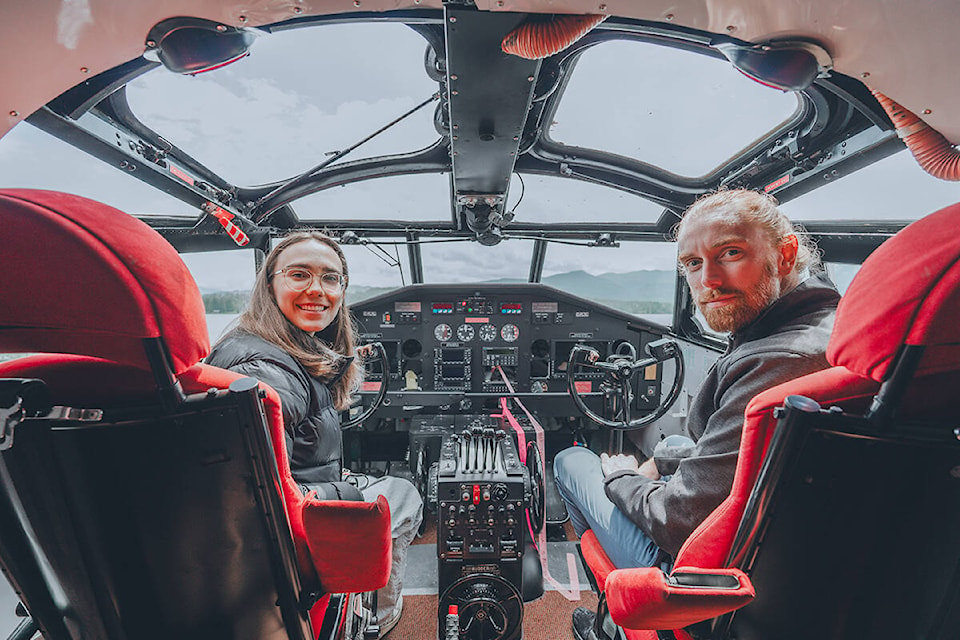Convention-goers were told to reach for the skies at this week’s B.C. Aviation Council conference.
Zara Rutherford, who in 2021 and 2022 became the youngest female pilot to fly solo around the world, was the signature speaker on the first day of the conference Tuesday, May 28, at the Vancouver Island Conference Centre in Nanaimo.
The daughter of two pilots had been flying for three or four years by the time she finished high school, and it had always been a dream of hers to fly around the world.
“I thought that would be the most amazing adventure and I had always assumed it was impossible,” she said. “I thought that’s something you read about in books, see in movies; I knew that it was expensive. And so it was always out of reach until … I thought, with that attitude, nothing’s going to happen.”
When Rutherford, now 21, first started planning her trip, she wasn’t setting out to break any kind of record, but then learned that the youngest woman to fly around the world had done so at age 30.
The Guinness World Record requirements involved passing through two antipodal points on the globe, that is to say, diametrically opposite. She chose cities in Indonesia and Colombia, and planned the rest of the route accordingly, starting and ending in her hometown of Kortrijk, Belgium. She crossed the Atlantic via Iceland and Greenland, and crossed the Pacific and Arctic oceans over the Bering Strait.
She had completed trans-Atlantic flights by the time she started her trip, so she had some idea of what was in store.
“If you can do the long, over-water [flights] in cold environments with pretty harsh weather, the rest of the world is pretty easy, in comparison,” she said.
As a pilot, Rutherford was exempted from a lot of visas, but there were other complexities with flight plans, overflight and landing permits and other regulations. Her Shark ultralight plane was ‘visual flight rules’ only, meaning she wasn’t allowed to fly into clouds. Countries like Egypt and Saudi Arabia were strict with altitudes and routes, and she had to give North Korea a wide berth. Flying through Russia – before the invasion of Ukraine – she was given an unfavourable flight plan requiring altitudes of 8,000 feet, more than double her preference, that would have tested her plane’s engine with temperatures of -30 C and below. So she wasn’t afraid to alter her course a little bit.
“Because I was so remote in Siberia, they had no idea where I was and I could kind of do whatever I wanted, because they couldn’t track me anyways,” she said.
Her plane held up well. No matter where she stopped for maintenance, whether in Alaska, Indonesia or South Korea, it was easy to find mechanics to work on her Rotax engine, a very common model.
It was mostly the weather that delayed her journey. She spent a month in Alaska and then a month in Siberia waiting for breaks in the clouds, both incredible experiences, she said, but cold ones. Communication, at least in the sky, was rarely a problem as English is spoken on the radio almost everywhere.
Rutherford saw the world from perspectives that few people will ever get. She flew over Saharan sand dunes closely enough to see camels, admired the wilderness of Canada and Alaska, sampled all kinds of food, and met new people everywhere she went.
“People-wise, culture-wise, every place was so different, yet alike – people were generous, kind,” Rutherford said.
After five months, she made it back home to her family, friends and cats.
“It was quite strange, because I had gone five months without seeing somebody that I knew, a face that I recognized. It was always new people. So that was really one of the first things that struck me was, I know these people and I know these faces,” she said.
As Rutherford tells and re-tells stories from her adventure, she tries to stress that nothing is impossible. Ultimately, she was able to get the sponsorships to pay for her trip and all the help she needed along the way, so in retrospect, the biggest reason it happened for her was because she decided she wanted to do it and that she was going to do it.
She hopes to motivate other girls and women to get into aviation. Planes don’t care about the pilot’s gender, she said, and there are good career opportunities to pursue. As the saying goes, the sky’s the limit.
“As a girl, I was always quite discouraged growing up, because I never saw other women doing what I wanted to do,” she said. “So I would say to other girls [now], just do it. It’s so much fun, it’s so rewarding. It’s amazing.”
READ ALSO: Teen pilot sets age record for solo flight around world



